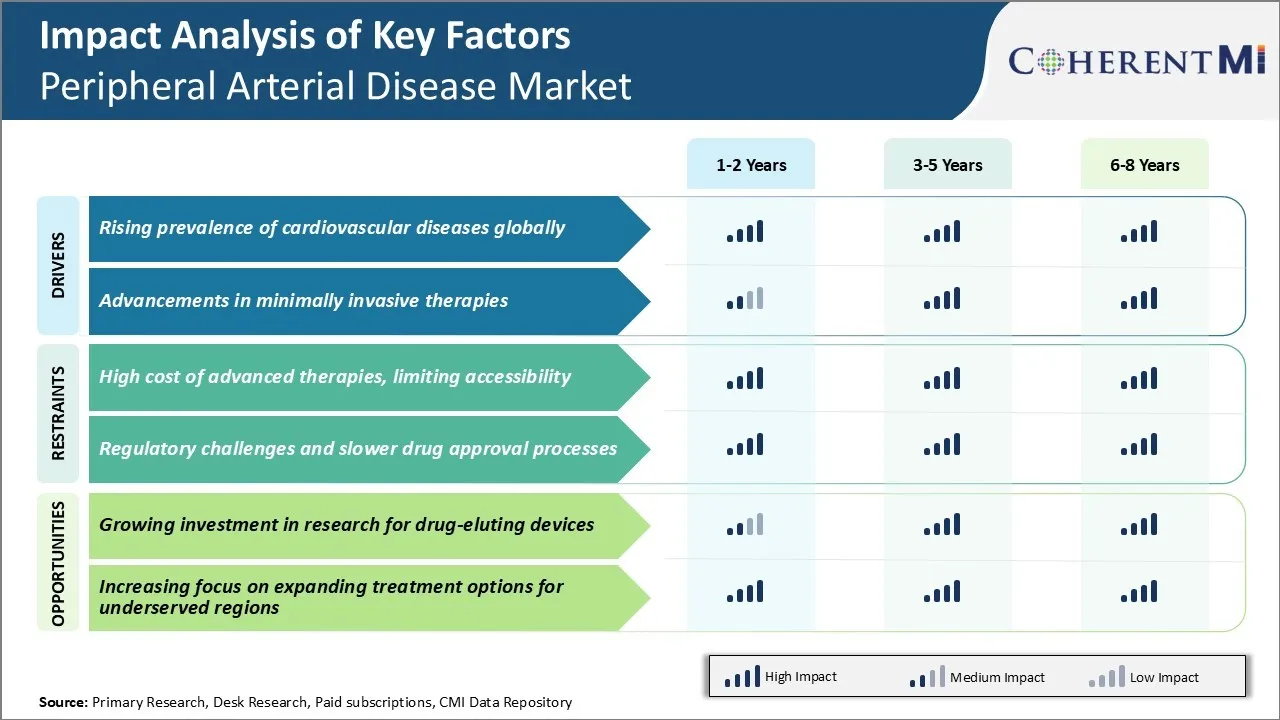Peripheral Arterial Disease Market Trends
Market Driver - Rising Prevalence of Cardiovascular Diseases and Improved Diagnostic Capabilities
As atherosclerosis affects a large population worldwide, it consequently leads to a rise in the number of people experiencing PAD symptoms and requiring treatment. Experts have noticed that incidence of PAD typically increases with age and is higher in people with long-standing diabetes or a history of smoking. Developed countries with aging populations and higher acceptance of sedentary lifestyle are thus expected to contribute largely to the PAD patient pool.
Another factor driving up PAD cases is improved diagnostic capabilities. Advancements in non-invasive imaging technologies have made it possible for doctors to detect even mild stages of PAD which may have gone unnoticed earlier. Greater awareness among physicians as well as people regarding symptoms of PAD is also leading to more cases being picked up for further examination and management. While this may temporarily inflate numbers, it ultimately helps identify at-risk groups and enables timely clinical intervention to address the condition and prevent limb compromise.
Overall, as cardiovascular illnesses continue to impose a significant disease burden worldwide owing to changes in demographics and underlying lifestyle trends, the prevalence of PAD as a possible consequence is likely to follow an ascending trajectory.
Market Driver - Advancements in Minimally Invasive Therapies
Rapid technological progress within the medical device segment has transformed the PAD treatment landscape considerably, one of the major drivers being the emergence of advanced minimally invasive methodologies. Some of the main developments which have improved clinical outcomes while facilitating less trauma include balloon and mechanical atherectomy devices.
Building upon early successes, manufacturers have brought to market newer generation drug-coated balloons, dedicated PAD stents and atherectomy systems incorporating valuable design enhancements. Additionally, progress in the fields of robotics and 3D printing are giving rise to innovative therapies such as implantable renal flow regulators. In the long run, such advancements could help minimize amputation risks especially for critical limb ischemia patients through personalized interventional solutions.
Healthcare providers likewise are exhibiting higher preference for minimally invasive PAD management given evidence of tangible advantages like shorter hospital stays, faster recovery times, lower complication risks and superior limb salvage capabilities compared to open surgeries.
Consequently, the uptake of cutting-edge endovascular devices and techniques is witnessing a substantial rise worldwide which is propelling the overall market growth. Looking ahead, continued improvements in catheter-based products hold noteworthy potential to further transform PAD care.

Market Challenge: High Cost of Advanced Therapies, Limiting Accessibility
One of the major challenges faced by the peripheral arterial disease (PAD) market is the high cost of advanced therapies. As the disease progresses, more complex procedures such as balloon angioplasty and stenting are required to open blocked arteries and improve blood flow.
However, these procedures involve the use of expensive medical devices and technologies. For instance, drug-eluting stents that are used to prevent re-narrowing of arteries post-procedure cost anywhere between $3000 to $5000 per stent. Similarly, atherectomy devices used to break up and remove blockages cost over $10000 per device.
The economic burden of such expensive treatments is limiting their accessibility especially in developing nations and for individuals without adequate health insurance coverage. As per our analysis, nearly 25-30% of PAD patients requiring advanced intervention do not undergo the procedure due to affordability issues. This has significant health implications as well as many would progress to the critical limb-threatening stage without immediate treatment.
Several markets like India, China, Brazil etc that are forecasted to see huge growth in the patient base may see that impacted due to this challenge. Operators are facing pricing pressure which can hamper revenue growth if not addressed.
Market Opportunity - Growing Investment in Research for Drug-eluting Devices for Market
One major opportunity for the PAD market lies in the growing investment and research in the area of drug-eluting devices. Conventional devices like balloon angioplasty and bare-metal stents require re-intervention in 30-50% of cases due to re-narrowing of arteries over time. This has driven extensive research into drug-eluting technologies that can deliver drugs locally over a period to prevent this re-narrowing.
Several startups as well large players are putting resources into developing drug-coated balloons and stents. Some of the drugs under investigation include paclitaxel, sirolimus etc. that can promote healing and inhibit cell proliferation responsible for re-blockage.
If successfully developed, such drug-eluting technologies can prove highly disruptive for the market. It can provide long-term patency rates comparable to bypass surgeries in a minimally invasive manner. This will not only help address the challenge of repeat procedures but also improve patient compliance and experience.
Given the size of opportunity, venture funding in this area has increased manifolds over the last few years. Successful products can garner a huge market share and premium pricing in the short to medium terms. It is thus a lucrative avenue for innovation and growth in the vascular devices segment.